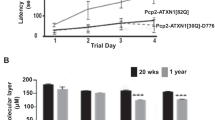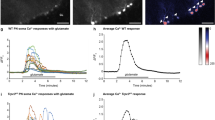Abstract
Ischemic brain damage is triggered by glutamate excitotoxicity resulting in neuronal cell death. Previous research has demonstrated that N-methly-d-aspartate (NMDA) receptor activation triggers downstream calcium-dependent signaling pathways, specifically Ca2+/calmodulin-dependent protein kinase II (CaMKII). Inhibiting CaMKII is protective against hippocampal ischemic injury, but there is little known about its role in the cerebellum. To examine the neuroprotective potential of CaMKII inhibition in Purkinje cells, we subjected C57BL/6 or CaMKIIα KO male mice (8–12 weeks old) to cardiac arrest followed by cardiopulmonary resuscitation (CA/CPR). We performed a dose-response study for tat-CN19o and cerebellar injury was analyzed at 7 days after CA/CPR. Acute signaling was assessed at 6 h after CA/CPR using Western blot analysis. We observed increased phosphorylation of the T286 residue of CaMKII, suggesting increased autonomous activation. Analysis of Purkinje cell density revealed a decrease in cell density at 7 days after CA/CPR that was prevented with tat-CN19o at doses of 0.1 and 1 mg/kg. However, neuroprotection in the cerebellum required doses that were 10-fold higher than what was needed in the hippocampus. CaMKIIα KO mice subjected to sham surgery or CA/CPR had similar Purkinje cell densities, suggesting CaMKIIα is required for CA/CPR-induced injury in the cerebellum. We also observed a CA/CPR-induced activation of death-associated protein kinase (DAPK1) that tat-CN19o did not block. In summary, our findings indicate that inhibition of autonomous CaMKII activity is a promising therapeutic approach that is effective across multiple brain regions.




Similar content being viewed by others
References
Benjamin EJ, Virani SS, Callaway CW, Chamberlain AM, Chang AR, Cheng S et al (2018) Heart disease and stroke statistics-2018 update: a report from the American Heart Association. Circulation 137(12):e67–e492
Buanes EA, Gramstad A, Søvig KK, Hufthammer KO, Flaatten H, Husby T, Langørgen J, Heltne JK (2015) Cognitive function and health-related quality of life four years after cardiac arrest. Resuscitation 89:13–18
Khot S, Tirschwell DL (2006) Long-term neurological complications after hypoxic-ischemic encephalopathy. Semin Neurol 26(4):422–431
Venkatesan A, Frucht S (2006) Movement disorders after resuscitation from cardiac arrest. Neurol Clin 24(1):123–132
Bunch TJ, White RD, Smith GE, Hodge DO, Gersh BJ, Hammill SC, Shen WK, Packer DL (2004) Long-term subjective memory function in ventricular fibrillation out-of-hospital cardiac arrest survivors resuscitated by early defibrillation. Resuscitation 60(2):189–195
Lim C, Verfaellie M, Schnyer D, Lafleche G, Alexander MP (2014) Recovery, long-term cognitive outcome and quality of life following out-of-hospital cardiac arrest. J Rehabil Med 46(7):691–697
Madl C, Holzer M (2004) Brain function after resuscitation from cardiac arrest. Curr Opin Crit Care 10(3):213–217
Deng G, Orfila JE, Dietz RM, Moreno-Garcia M, Rodgers KM, Coultrap SJ, Quillinan N, Traystman RJ et al (2017) Autonomous CaMKII activity as a drug target for histological and functional neuroprotection after resuscitation from cardiac arrest. Cell Rep 18(5):1109–1117
Cronberg T, Lilja G, Horn J, Kjaergaard J, Wise MP, Pellis T, Hovdenes J, Gasche Y et al (2015) Neurologic function and health-related quality of life in patients following targeted temperature management at 33 degrees C vs 36 degrees C after out-of-hospital cardiac arrest: a randomized clinical trial. JAMA Neurol 72(6):634–641
Lilja G, Nielsen N, Friberg H, Horn J, Kjaergaard J, Nilsson F, Pellis T, Wetterslev J et al (2015) Cognitive function in survivors of out-of-hospital cardiac arrest after target temperature management at 33 degrees C versus 36 degrees C. Circulation 131(15):1340–1349
Dell’anna AM, Scolletta S, Donadello K, Taccone FS (2014) Early neuroprotection after cardiac arrest. Curr Opin Crit Care 20(3):250–258
Hypothermia after Cardiac Arrest Study G (2002) Mild therapeutic hypothermia to improve the neurologic outcome after cardiac arrest. N Engl J Med 346(8):549–556
Bernard SA, Gray TW, Buist MD, Jones BM, Silvester W, Gutteridge G, Smith K (2002) Treatment of comatose survivors of out-of-hospital cardiac arrest with induced hypothermia. N Engl J Med 346(8):557–563
Arrich J, Holzer M, Herkner H, Mullner M (2009) Hypothermia for neuroprotection in adults after cardiopulmonary resuscitation. Cochrane Database Syst Rev 4:CD004128
Ng T, Graham DI, Adams JH, Ford I (1989) Changes in the hippocampus and the cerebellum resulting from hypoxic insults: frequency and distribution. Acta Neuropathol 78(4):438–443
Kofler J, Hattori K, Sawada M, DeVries A, Martin L, Hurn P et al (2004) Histopathological and behavioral characterization of a novel model of cardiac arrest and cardiopulmonary resuscitation in mice. J Neurosci Methods 136(1):33–44
Horn M, Schlote W (1992) Delayed neuronal death and delayed neuronal recovery in the human brain following global ischemia. Acta Neuropathol 85:79–87
Martin LJ, Al-Abdulla NA, Brambrink AM, Kirsch JR, Sieber FE, Portera-Cailliau C (1998) Neurodegeneration in excitotoxicity, global cerebral ischemia, and target deprivation: a perspective on the contributions of apoptosis and necrosis. Brain Res Bull 46(4):281–309
Sato M, Hashimoto H, Kosaka F (1990) Histological changes of neuronal damage in vegetative dogs induced by 18 minutes of complete global brain ischemia: two-phase damage of Purkinje cells and hippocampal CA1 pyramidal cells. Acta Neuropathol 80(5):527–534
Martin LJ, Sieber FE, Traystman RJ (2000) Apoptosis and necrosis occur in separate neuronal populations in hippocampus and cerebellum after ischemia and are associated with differential alterations in metabotropic glutamate receptor signaling pathways. J Cereb Blood Flow Metab 20(1):153–167
Globus MY, Busto R, Martinez E, Valdes I, Dietrich WD, Ginsberg MD (1991) Comparative effect of transient global ischemia on extracellular levels of glutamate, glycine, and gamma-aminobutyric acid in vulnerable and nonvulnerable brain regions in the rat. J Neurochem 57(2):470–478
Hertz L (2008) Bioenergetics of cerebral ischemia: a cellular perspective. Neuropharmacology 55(3):289–309
Gilbert PF, Thach WT (1977) Purkinje cell activity during motor learning. Brain Res 128(2):309–328
Llinás R, Welsh JP (1993) On the cerebellum and motor learning. Curr Opin Neurobiol 3(6):958–965
Bastian AJ (2006) Learning to predict the future: the cerebellum adapts feedforward movement control. Curr Opin Neurobiol 16(6):645–649
Thach WT (1998) A role for the cerebellum in learning movement coordination. Neurobiol Learn Mem 70(1–2):177–188
Ikonomidou C, Turski L (2002) Why did NMDA receptor antagonists fail clinical trials for stroke and traumatic brain injury? Lancet Neurol 1(6):383–386
Lynch DR, Guttmann RP (2002) Excitotoxicity: perspectives based on N-methyl-D-aspartate receptor subtypes. J Pharmacol Exp Ther 300(3):717–723
Arundine M, Tymianski M (2004) Molecular mechanisms of glutamate-dependent neurodegeneration in ischemia and traumatic brain injury. Cell Mol Life Sci 61(6):657–668
Szydlowska K, Tymianski M (2010) Calcium, ischemia and excitotoxicity. Cell Calcium 47(2):122–129
Quillinan N, Grewal H, Deng G, Shimizu K, Yonchek JC, Strnad F, Traystman RJ, Herson PS (2015) Region-specific role for GluN2B-containing NMDA receptors in injury to Purkinje cells and CA1 neurons following global cerebral ischemia. Neuroscience 284:555–565
Kaufman AM, Milnerwood AJ, Sepers MD, Coquinco A, She K, Wang L, Lee H, Craig AM et al (2012) Opposing roles of synaptic and extrasynaptic NMDA receptor signaling in cocultured striatal and cortical neurons. J Neurosci 32(12):3992–4003
Bayer KU, Schulman H (2019 (in press)) CaM kinase: still intriguing at 40. Neuron 103:380–394
Lee HK, Barbarosie M, Kameyama K, Bear MF, Huganir RL (2000) Regulation of distinct AMPA receptor phosphorylation sites during bidirectional synaptic plasticity. Nature 405(6789):955–959
Barria A, Malinow R (2005) NMDA receptor subunit composition controls synaptic plasticity by regulating binding to CaMKII. Neuron 48(2):289–301
Buard I, Coultrap SJ, Freund RK, Lee YS, Dell’Acqua ML, Silva AJ, Bayer KU (2010) CaMKII “autonomy” is required for initiating but not for maintaining neuronal long-term information storage. J Neurosci 30(24):8214–8220
Lucchesi W, Mizuno K, Giese KP (2011) Novel insights into CaMKII function and regulation during memory formation. Brain Res Bull 85(1–2):2–8
Coultrap SJ, Bayer KU (2011) Improving a natural CaMKII inhibitor by random and rational design. PLoS One 6(10):e25245
van Woerden GM, Hoebeek FE, Gao Z, Nagaraja RY, Hoogenraad CC, Kushner SA, Hansel C, de Zeeuw CI et al (2009) betaCaMKII controls the direction of plasticity at parallel fiber-Purkinje cell synapses. Nat Neurosci 12(7):823–825
Wang X, Zhang C, Szabo G, Sun QQ (2013) Distribution of CaMKIIalpha expression in the brain in vivo, studied by CaMKIIalpha-GFP mice. Brain Res 1518:9–25
Nagasaki N, Hirano T, Kawaguchi SY (2014) Opposite regulation of inhibitory synaptic plasticity by alpha and beta subunits of Ca(2+)/calmodulin-dependent protein kinase II. J Physiol 592(22):4891–4909
Nair S, Hagberg H, Krishnamurthy R, Thornton C, Mallard C (2013) Death associated protein kinases: molecular structure and brain injury. Int J Mol Sci 14(7):13858–13872
Hutchens MP, Traystman RJ, Fujiyoshi T, Nakayama S, and Herson PS (2011) Normothermic cardiac arrest and cardiopulmonary resuscitation: a mouse model of ischemia-reperfusion injury. J Vis Exp (54)
Hell JW (2014) CaMKII: claiming center stage in postsynaptic function and organization. Neuron 81(2):249–265
Hansel C, Jeu M, Belmeguenai A, Houtman SH, Buitendijk GS, Andreev D et al (2006) αCaMKII is essential for cerebellar LTD and motor learning. Neuron 51(6):835–843
Coultrap SJ, Vest RS, Ashpole NM, Hudmon A, Bayer KU (2011) CaMKII in cerebral ischemia. Acta Pharmacol Sin 32(7):861–872
Takano H, Fukushi H, Morishima Y, Shirasaki Y (2003) Calmodulin and calmodulin-dependent kinase II mediate neuronal cell death induced by depolarization. Brain Res 962(1–2):41–47
Gao J, Duan B, Wang DG, Deng XH, Zhang GY, Xu L, Xu TL (2005) Coupling between NMDA receptor and acid-sensing ion channel contributes to ischemic neuronal death. Neuron 48(4):635–646
Gurd JW, Rawof S, Zhen Huo J, Dykstra C, Bissoon N, Teves L, Wallace MC, Rostas JAP (2008) Ischemia and status epilepitcus result in enhanced phosphorylation of calcium and calmodulin-stimulated protein kinase II on threonine 253. Brain Res 1218:158–165
Ahmed ME, Dong Y, Lu Y, Tucker D, Wang R, Zhang Q (2017) Beneficial effects of a CaMKIIalpha inhibitor TatCN21 peptide in global cerebral ischemia. J Mol Neurosci 61(1):42–51
Rostas JA, Hoffman A, Murtha LA, Pepperall D, McLeod DD, Dickson PW et al (2017) Ischaemia- and excitotoxicity-induced CaMKII-mediated neuronal cell death: the relative roles of CaMKII autophosphorylation at T286 and T253. Neurochem Int 104:6–10
Ashpole NM, Song W, Brustovetsky T, Engleman EA, Brustovetsky N, Cummins TR, Hudmon A (2012) Calcium/calmodulin-dependent protein kinase II (CaMKII) inhibition induces neurotoxicity via dysregulation of glutamate/calcium signaling and hyperexcitability. J Biol Chem 287(11):8495–8506
Shamloo M, Soriano L, Wieloch T, Nikolich K, Urfer R, Oksenberg D (2005) Death-associated protein kinase is activated by dephosphorylation in response to cerebral ischemia. J Biol Chem 280(51):42290–42299
Tu W, Xu X, Peng L, Zhong X, Zhang W, Soundarap MM et al (2010) DAPK1 interaction with NMDA receptor NR2B subunits mediates brain damage in stroke. Cell 140(2):222–234
He C, Stroink AR, Wang CX (2014) The role of DAPK-BimEL pathway in neuronal death induced by oxygen-glucose deprivation. Neuroscience 258:254–262
Fujita Y, Yamashita T (2014) Role of DAPK in neuronal cell death. Apoptosis 19(2):339–345
Pei L, Shang Y, Jin H, Wang S, Wei N, Yan H, Wu Y, Yao C et al (2014) DAPK1-p53 interaction converges necrotic and apoptotic pathways of ischemic neuronal death. J Neurosci 34(19):6546–6556
Meng F, Guo J, Zhang Q, Song B, Zhang G (2003) Autophosphorylated calcium/calmodulin-dependent protein kinase II alpha (CaMKII alpha) reversibly targets to and phosphorylates N-methyl-D-aspartate receptor subunit 2B (NR2B) in cerebral ischemia and reperfusion in hippocampus of rats. Brain Res 967(1–2):161–169
Jiang H, Fang J, Xing J, Wang L, Wang Q, Wang Y, Li Z, Liu R (2019) Tilianin mediates neuroprotection against ischemic injury by attenuating CaMKII-dependent mitochondrion-mediated apoptosis and MAPK/NF-kappaB signaling. Life Sci 216:233–245
Lu Q, Harris VA, Sun X, Hou Y, Black SM (2013) Ca(2)(+)/calmodulin-dependent protein kinase II contributes to hypoxic ischemic cell death in neonatal hippocampal slice cultures. PLoS One 8(8):e70750
Chen CH, Wang WJ, Kuo JC, Tsai HC, Lin JR, Chang ZF, Chen RH (2005) Bidirectional signals transduced by DAPK-ERK interaction promote the apoptotic effect of DAPK. EMBO J 24(2):294–304
Funding
This work was supported by NINDS K01 NS086969 (NQ), NINDS R01 NS080851 (PSH, UB) and Gates Summer Internship Program (MR).
Author information
Authors and Affiliations
Corresponding author
Ethics declarations
All experiments were approved by the Institutional Animal Care and Use Committee (IACUC) of the University of Colorado, School of Medicine, and were performed according to the guidelines from the National Institutes of Health.
Additional information
Publisher’s Note
Springer Nature remains neutral with regard to jurisdictional claims in published maps and institutional affiliations.
Rights and permissions
About this article
Cite this article
Chalmers, N.E., Yonchek, J., Steklac, K.E. et al. Calcium/Calmodulin-Dependent Kinase (CaMKII) Inhibition Protects Against Purkinje Cell Damage Following CA/CPR in Mice. Mol Neurobiol 57, 150–158 (2020). https://doi.org/10.1007/s12035-019-01765-9
Received:
Accepted:
Published:
Issue Date:
DOI: https://doi.org/10.1007/s12035-019-01765-9




